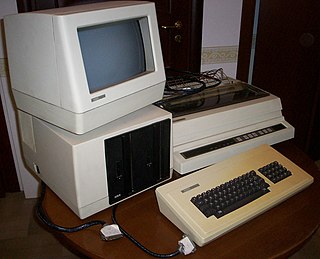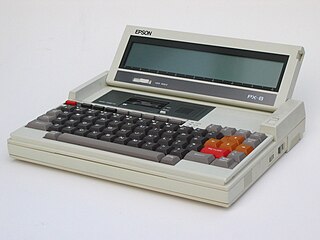Amstrad was a British electronics company, founded in 1968 by Alan Sugar at the age of 21. The name is a contraction of Alan Michael Sugar Trading. It was first listed on the London Stock Exchange in April 1980. During the late 1980s, Amstrad had a substantial share of the PC market in the UK. Amstrad was once a FTSE 100 Index constituent, but since 2007 has been wholly owned by Sky UK. As of 2006, Amstrad's main business was manufacturing Sky UK interactive boxes. In 2010, Sky integrated Amstrad's satellite division as part of Sky so they could make their own set-top boxes in-house.

The Xerox 820 Information Processor is an 8-bit desktop computer sold by Xerox in the early 1980s. The computer runs under the CP/M operating system and uses floppy disk drives for mass storage. The microprocessor board is a licensed variant of the Big Board computer.
Kaypro Corporation was an American home and personal computer manufacturer based out of San Diego in the 1980s. The company was founded by Non-Linear Systems (NLS) to compete with the popular Osborne 1 portable microcomputer. Kaypro produced a line of rugged, "luggable" CP/M-based computers sold with an extensive software bundle which supplanted its competitors and quickly became one of the top-selling personal computer lines of the early 1980s.

The Osborne 1 is the first commercially successful portable computer, released on April 3, 1981 by Osborne Computer Corporation. It weighs 24.5 lb (11.1 kg), cost US$1,795, and runs the CP/M 2.2 operating system. It is powered from a wall socket, as it has no on-board battery, but it is still classed as a portable device since it can be hand-carried when the keyboard is closed.

The Apple IIc, the fourth model in the Apple II series of personal computers, is Apple Computer's first endeavor to produce a portable computer. The result was a 7.5 lb (3.4 kg) notebook-sized version of the Apple II that could be transported from place to place — a portable alternative and complement to the Apple IIe. The c in the name stood for compact, referring to the fact it was essentially a complete Apple II computer setup squeezed into a small notebook-sized housing. While sporting a built-in floppy drive and new rear peripheral expansion ports integrated onto the main logic board, it lacks the internal expansion slots and direct motherboard access of earlier Apple II models, making it a closed system like the Macintosh. However, that was the intended direction for this model — a more appliance-like machine, ready to use out of the box, requiring no technical know-how or experience to hook up and therefore attractive to first-time users.

The IBM PC Convertible is a laptop computer made by IBM, first sold in April 1986. The Convertible was IBM's first laptop-style computer, following the luggable IBM Portable, and introduced the 3½-inch floppy disk format to the IBM product line. Like modern laptops, it featured power management and the ability to run from batteries.

Columbia Data Products, Inc. (CDP) is a company which produced the first legally reverse-engineered IBM PC clones. It faltered in that market after only a few years, and later reinvented itself as a software development company.

Compaq's first computers' form factors were portable, also called "luggables", and then "lunchbox computers", and together constituted the Compaq Portable series. These computers measured approximately 16 inches (410 mm) deep, 8 inches (200 mm) tall, and approximately 20 inches (510 mm) wide. As the products evolved, laptops and notebooks were created offing a new level of portability that caused the market to explode.

The Compaq Portable was an early portable computer which was one of the first IBM PC compatible systems. It was Compaq Computer Corporation's first product, to be followed by others in the Compaq Portable series and later Compaq Deskpro series. It was not simply an 8088-CPU computer that ran a Microsoft DOS as a PC "work-alike", but contained a reverse-engineered BIOS, and a version of MS-DOS that was so similar to IBM's PC DOS that it ran nearly all its application software. The computer was also an early variation on the idea of an "all-in-one".

The Data General/One (DG-1) was a laptop introduced in 1984 by Data General.

The Epson PX-8 a.k.a. Geneva was a small laptop computer made by the Epson Corporation in the mid-1980s.
Zenith Data Systems, Inc. (ZDS), was a division of Zenith Electronics founded in 1979 after Zenith acquired the Heath Company, which had entered the personal computer market in 1977. Headquartered in Benton Harbor, Michigan, Zenith sold personal computers under both the Heath/Zenith and Zenith Data Systems names.

The Sharp PC-5000 was a pioneering laptop computer, announced by Sharp Corporation of Japan in November 1983. It employed a clamshell design in which the display closes over the keyboard, like the earlier GRiD Compass and contemporary Gavilan SC.
George Morrow was part of the early microcomputer industry in the United States. Morrow promoted and improved the S-100 bus used in many early microcomputers. Called "one of the microcomputer industry's iconoclasts" by Richard Dalton in the Whole Earth Software Catalog, Morrow was also a member of the Homebrew Computer Club.
The Z-100 computer is a personal computer made by Zenith Data Systems (ZDS). It was a competitor to the IBM PC.

The history of laptops describes the efforts, begun in the 1970s, to build small, portable personal computers that combine the components, inputs, outputs and capabilities of a desktop computer in a small chassis.

The Zorba was a portable computer running the CP/M operating system manufactured in 1983 and 1984. It was originally manufactured by Telcon Industries of Fort Lauderdale, Florida, a company specialized in telecommunication equipment manufacturing.

The SupersPort is a line of PC-compatible laptops manufactured by Zenith Data Systems and sold from 1988 to 1993. The first two main entries in the SupersPort line included either an Intel 80286 microprocessor clocked at 12 MHz or an 8088 processor clocked at 8 or 4.77 MHz, switchable. Later entries included the 386SX, 486SX and 486 processors. The SupersPort 286 in particular was one of the top-selling laptops of the late 1980s, although Zenith's position in this segment faltered by the early 1990s.













